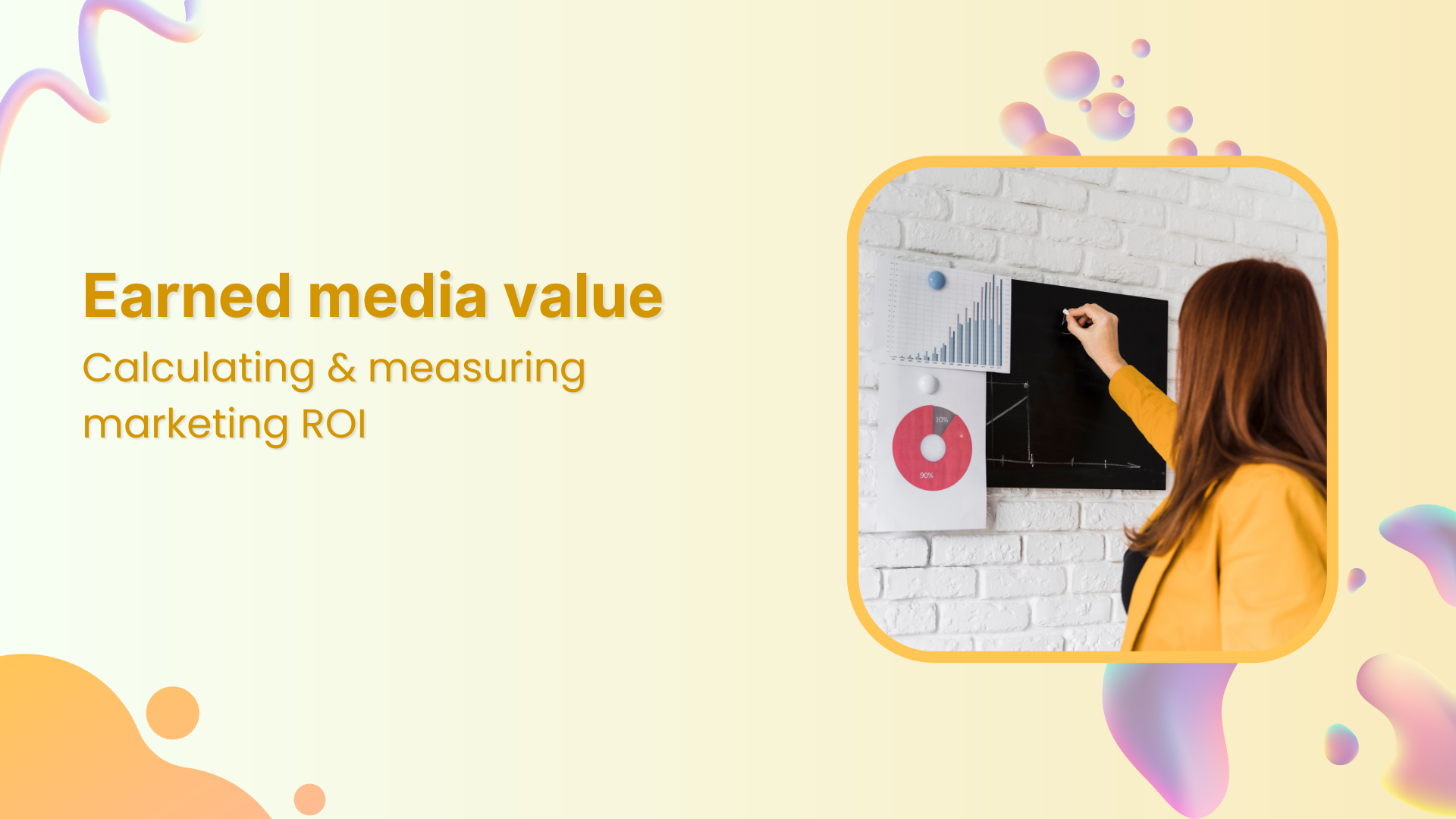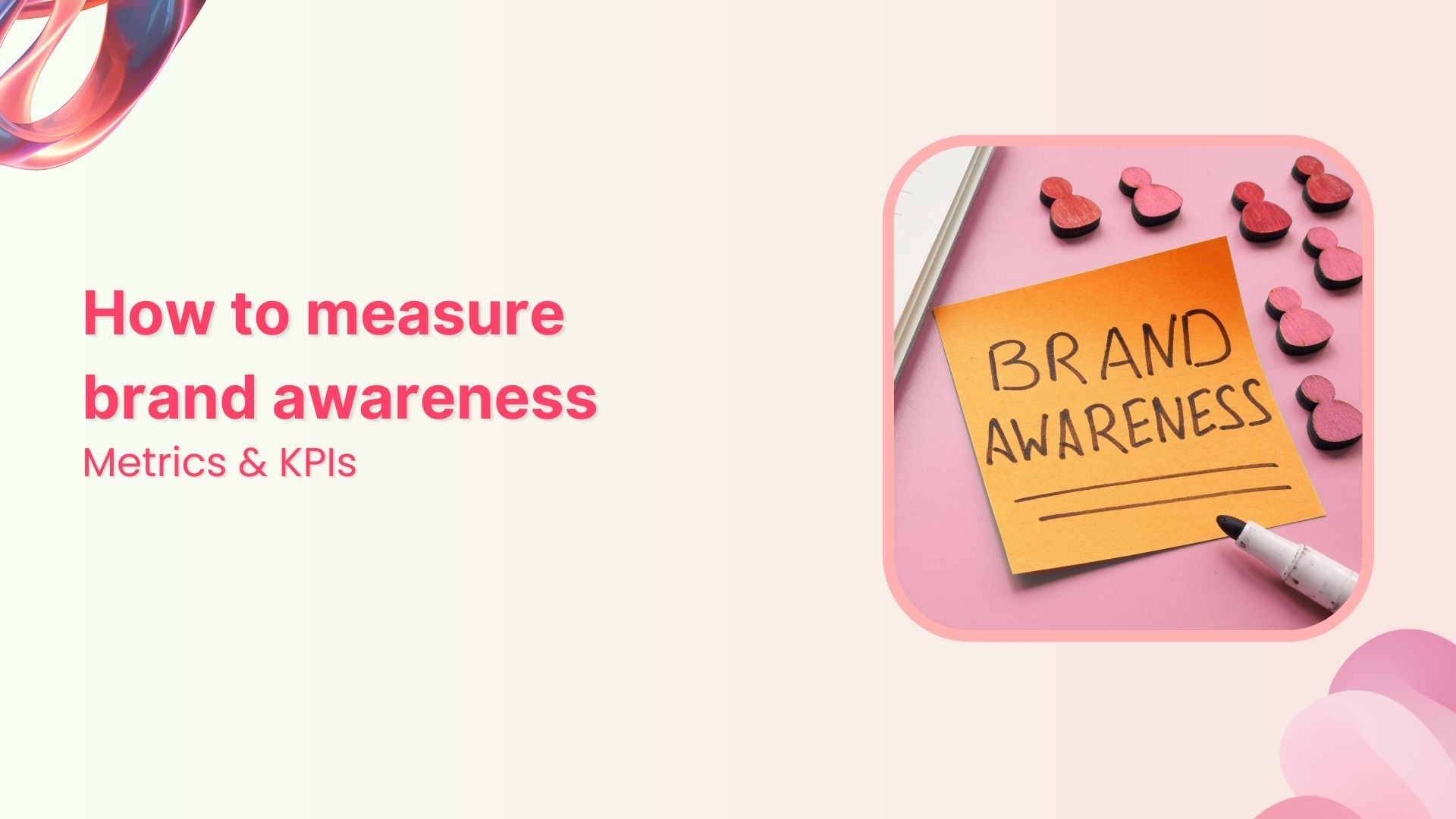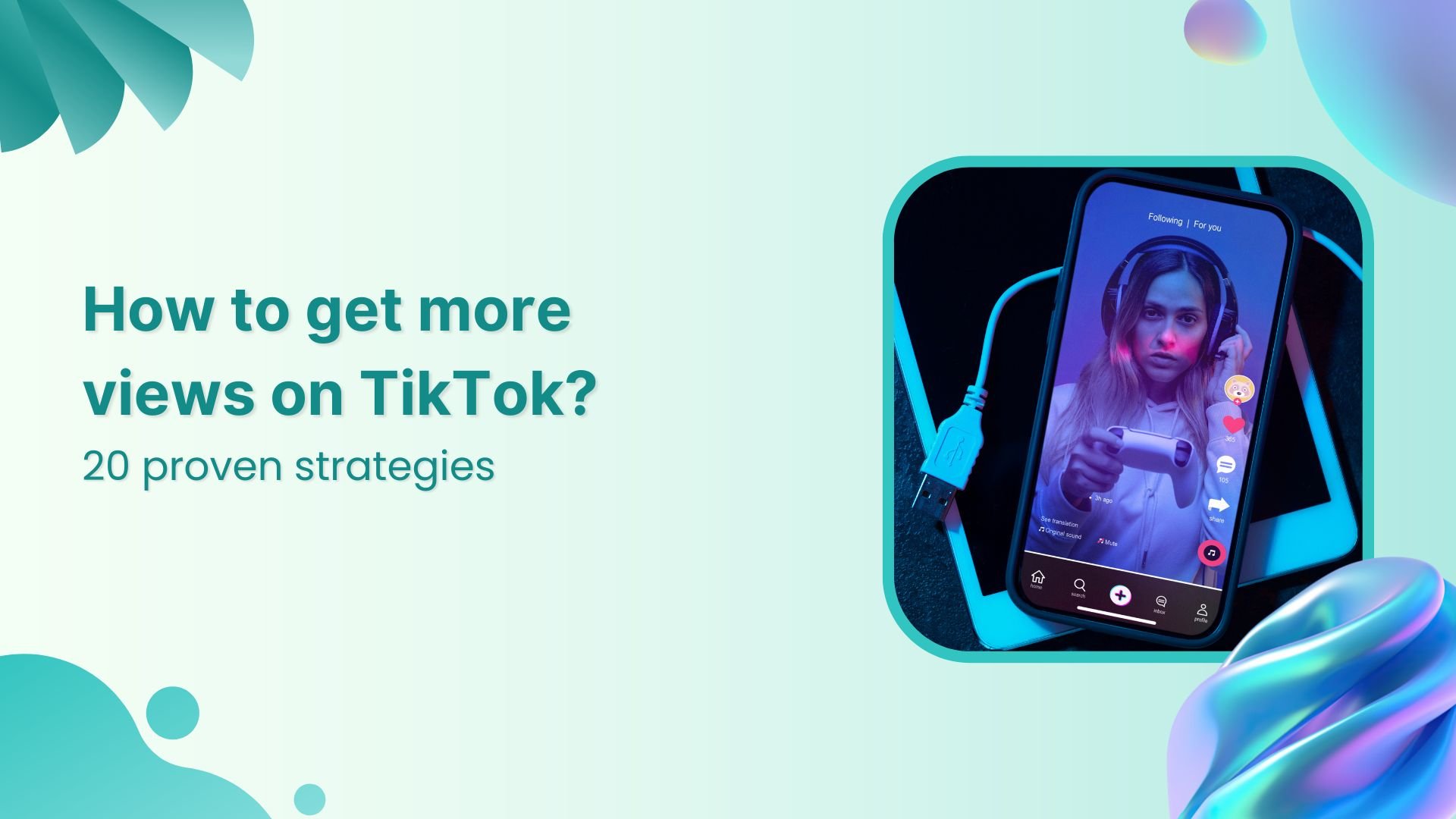AI video generation is now live - with all the premium models. Start creating
Earned media value: Calculating & measuring marketing ROI

Every share, mention, tag, and review your brand receives represents something valuable. but how valuable, exactly? This is the primary question that the concept of “earned media value” is designed to answer.
Measuring earned media value is also vital because while paid advertising comes with clear price tags and owned media costs are easy to track, the worth of organic brand mentions often remains a mystery for marketers.
Simplified social media marketing for individuals & agencies.
Try ContentStudio for FREE
In this comprehensive guide, we’ll explore everything you need to know about earned media value, starting from its fundamental meaning to practical calculation methods. Whether you’re managing social campaigns, working with influencers, or simply trying to prove your marketing ROI, you’ll learn how to quantify the impact of every organic mention your brand receives.
What is earned media value?
Earned media value (EMV) is a metric that assigns a monetary value to organic brand exposure gained through unpaid channels. Unlike paid advertisements or owned content, earned media represents authentic mentions, shares, reviews, and recommendations that people create about your brand voluntarily.
Think of it this way: when a customer shares your product on Instagram, an influencer mentions your service in their vlog, or a journalist features your company in an article, you’ve earned that visibility.
EMV helps you translate these organic interactions into dollars, making it easier to measure their impact alongside your paid marketing efforts.
Understanding the earned media value definition
The earned media value’s meaning extends beyond simple impressions or engagement counts. It represents the equivalent advertising cost you would have paid to achieve the same level of exposure through paid channels.
At its core, EMV answers a straightforward question:
- “If we had to pay for this organic coverage, what would it cost us?”
This comparison gives marketers a tangible way to communicate the value of PR campaigns, influencer partnerships, and social media strategies to stakeholders who think in budget terms.
However, EMV isn’t just about cost equivalency. It also reflects the quality and credibility of earned media. A mention from a trusted industry publication or a genuine customer testimonial often carries more weight than a paid advertisement because audiences view them as more authentic and trustworthy.

What is EMV in marketing?
In marketing terminology, EMV serves as a bridge between qualitative success and quantitative measurement. It transforms intangible brand mentions into concrete financial metrics that can be tracked, compared, and reported.
Marketers use EMV across various contexts:
- Public relations: Measuring the value of press coverage and media mentions against the cost of equivalent advertising space.
- Influencer marketing: Quantifying the worth of influencer posts, stories, and videos based on their reach and engagement rates.
- Social media management: Evaluating user-generated content, brand mentions, and viral campaigns in financial terms.
- Event marketing: Calculating the value of organic social media coverage from conferences, product launches, or brand activations.
The versatility of EMV makes it particularly valuable for integrated marketing strategies where multiple channels work together to build brand value and credibility.
Why is earned media value important for your brand?
Understanding the value of earned media goes far beyond creating impressive reports for your executives. It fundamentally changes how you approach marketing strategy and resource allocation.
Here are the benefits of earned media value for any business:
1. Data-backed marketing ROI
When you can demonstrate that your influencer campaign generated $50,000 in earned media value from a $10,000 investment, you’re speaking the language of business leaders. EMV transforms vague metrics like “brand awareness” into concrete financial returns that justify marketing budgets and secure future investments.
2. Optimize marketing budget
By measuring earned media value across different channels and campaigns, you identify which strategies deliver the highest return. If your Instagram collaborations generate three times the EMV of your X campaigns with the same budget, that’s actionable intelligence for reallocating resources.
3. Validate influencer partnerships
Not all influencers deliver equal value, even with similar follower counts. EMV reveals which partnerships drive genuine engagement and brand visibility. It helps you identify the most valuable relationships for long-term collaboration.
4. Strengthens campaign planning
Historical EMV data helps you set realistic goals for future campaigns. Instead of guessing at outcomes, you can project expected earned media value based on past performance, making your planning more strategic and data-driven.
5. Prove authentic brand reach
Unlike vanity metrics that can be manipulated, earned media represents genuine interest in your brand. High EMV indicates that people find your brand worth talking about, sharing, and recommending. This kind of organic growth is also the proof of sustainable business results.
How to calculate earned media value
Measuring earned media value requires both methodology and the right tools. The basic concept of EVM calculation is quite simple, but the actual calculation can vary based on your goals and available data.

Using the earned media value formula
The most common earned media value formula multiplies your earned media metrics by relevant cost benchmarks:
EMV = Impressions × CPM (Cost Per Thousand Impressions) / 1000
For example, if an influencer’s post about your brand reaches 500,000 people and your industry’s average CPM is $10, the calculation would be:
EMV = 500,000 × $10 / 1000 = $5,000
However, this basic formula only accounts for reach.
A more sophisticated approach factors in engagement:
EMV = (Impressions × CPM + Engagements × Cost Per Engagement) / 1000
This method recognizes that a like, comment, or share represents deeper interaction than a simple impression, and thus deserves additional value.
For influencer marketing specifically, many brands use:
EMV = Influencer’s Cost Per Post × Engagement Rate × Quality Score
The quality score accounts for factors like content relevance, audience alignment, and sentiment. A post from an influencer with 100,000 highly engaged, relevant followers might generate more value than one from someone with a million disconnected followers.
When calculating earned media value from press coverage, use:
EMV = Advertising Value Equivalency (AVE) × PR Multiplier
AVE represents what you would pay for the same ad space, while the PR multiplier (typically 2-5x) accounts for the added credibility of editorial coverage versus paid advertising.
Using an earned media value calculator
Manual calculations work for small-scale analysis, but most brands benefit from dedicated earned media value calculators and analytics platforms. These tools automate the process and provide more sophisticated insights.
1. Social media management platforms like ContentStudio offer built-in analytics that track mentions, engagement, and reach across multiple platforms. These systems can help you calculate EMV based on your predefined benchmarks and industry standards.

2. Influencer marketing platforms such as AspireIQ, Traackr, and Upfluence include EMV calculators specifically designed for influencer partnerships. They factor in follower demographics, engagement rates, and content performance to provide accurate valuations.

3. Media monitoring tools like Meltwater and Mention track brand mentions across news sites, blogs, and social media, then calculate their earned media value based on reach and publication authority.

4. PR measurement platforms, including Cision and TrendKite specialize in quantifying the value of press coverage using sophisticated algorithms that consider circulation, prominence, and message pull-through.

When choosing a calculator or platform, look for these features:
- Multi-channel tracking: Measures EMV across social media, news sites, blogs, and forums from a single dashboard
- Customizable benchmarks: Allows you to input your own CPM rates and multipliers based on your industry and goals
- Sentiment analysis: Differentiates between positive and negative mentions, adjusting EMV accordingly
- Historical comparison: Tracks EMV trends over time to identify growth patterns and campaign impact
- Export capabilities: Generates reports you can share with stakeholders and integrate into broader marketing analytics
The right tool depends on your specific needs. Brands focused primarily on social media might find comprehensive solutions in platforms like ContentStudio, while those with heavy PR and news coverage might need specialized media monitoring services.
Earned media value for social media platforms

Different social media platforms require different approaches to measuring earned media value. Each platform has unique engagement patterns, audience behaviors, and advertising costs that influence EMV calculations.
Tracking Facebook earned media value
Facebook remains a powerhouse for earned media, particularly through shares, comments, and user-generated content. Calculating Facebook earned media value requires understanding the platform’s specific metrics and advertising benchmarks.

Start by identifying the types of earned media on Facebook:
- Organic shares and mentions: When users share your content or tag your brand in posts
- User reviews and recommendations: Ratings and testimonials left on your business page
- Comment discussions: Engaged conversations on your posts that extend your reach
- Group mentions: Brand discussions in relevant Facebook groups
To calculate Facebook EMV, use the platform’s average CPM for your industry. As of 2025, Facebook CPMs typically range from $8 to $12, though this varies significantly by industry and target audience.
Multiply your organic reach by your benchmark CPM:
Facebook EMV = Organic Reach × Platform CPM / 1000
Don’t forget to add value for engagement. Facebook’s algorithm prioritizes meaningful interactions, so comments and shares carry substantial weight. Assign additional value to these actions based on your average cost per engagement from paid campaigns.
Related Read: Track, analyze, and improve: 11 Facebook analytics tools you need
Measuring earned media value on Instagram
Instagram’s visual nature and influencer ecosystem make it perhaps the most important platform for earned media value tracking. The platform’s engagement rates typically exceed other social networks, translating to higher EMV potential.

Instagram earned media comes in several forms:
- Influencer posts and stories: When influencers feature your brand organically or through gifted products
- User-generated content: Customer photos, videos, and reels featuring your products
- Brand mentions and tags: Posts where users tag your account or use your branded hashtags
- Comments and saves: Engagement signals that extend your content’s reach
Instagram EMV calculations should account for the platform’s higher engagement rates and visual impact. Instagram CPMs typically range from $5 to $12, but engagement rates often run 2-3 times higher than Facebook.
Use this enhanced formula for Instagram:
Instagram EMV = (Reach × CPM / 1000) + (Engagements × Cost Per Engagement) × Platform Multiplier
Stories deserve special attention in EMV calculations. While they disappear after 24 hours, Instagram stories generate immediate engagement and create urgency. Track story views, replies, and shares separately, applying your story ad costs as benchmarks.
Also Read: 15 Instagram analytics tools you should be using in 2025
Calculating earned media value from social media impressions
Impressions in social media form the foundation of most EMV calculations, but not all impressions carry equal value. Understanding how to properly calculate earned media value from impressions requires distinguishing between different types of exposure.
- Organic impressions occur when users see your content through non-paid means, such as via follows, shares, or algorithmic recommendations. These are the core of earned media value.
- Viral impressions happen when content spreads beyond your immediate audience through sharing and word-of-mouth. These deserve a premium valuation because they represent authentic interest and recommendation.
- Repeated impressions from the same user hold less value than unique impressions. If possible, focus on unique reach rather than total impressions for more accurate EMV.
To calculate EMV from impressions across platforms:
- Gather impression data: Collect total impressions from all organic sources, including user posts, shares, mentions, and stories
- Determine platform CPM: Research average CPM rates for each platform in your industry
- Apply the basic formula: EMV = (Total Impressions × CPM) / 1000
- Add engagement value: Include additional calculations for likes, comments, shares, and saves
- Apply quality adjustments: Increase value for highly relevant audiences or premium placements (like features on influential accounts)
Remember that impressions alone don’t tell the complete story. A post that generates 100,000 impressions but zero engagement delivers less true value than one with 10,000 impressions and 1,000 engaged interactions.
Earned media value in influencer marketing
We’ve already discussed the basics of how earned media value is closely associated with the influencer market. But it deserves more attention because influencer marketing is one of the most significant sources of earned media value for modern brands. When executed strategically, influencer partnerships generate authentic customer advocacy that resonates far beyond traditional advertising.
The relationship between influencer marketing and EMV is particularly interesting because it blurs the line between earned and paid media.
While brands compensate influencers for content creation, the resulting posts function as earned media in the eyes of the audience. Followers perceive influencer content as authentic recommendations rather than paid advertisements.
Calculating influencer EMV
You should start with the influencer’s engagement rate. This includes their average likes, comments, shares, and saves divided by their follower count.
An influencer with 50,000 followers and a 5% engagement rate (2,500 interactions per post) delivers more value than one with 100,000 followers and 1% engagement (1,000 interactions).
Next, consider content longevity. Instagram feed posts remain visible indefinitely, continuing to generate impressions and engagement. Stories disappear after 24 hours but often drive immediate action. YouTube videos accumulate views over time, creating compounding value. Weight your EMV calculations based on expected content lifespan.
Track EMV across the influencer funnel:
- Awareness stage: Measure EMV from initial product introductions and unboxing content
- Consideration stage: Calculate value from detailed reviews, tutorials, and comparison content
- Conversion stage: Track EMV from discount codes, swipe-up links, and direct purchase drivers
- Advocacy stage: Value ongoing organic mentions and genuine product recommendations

Many brands find that gifted products and long-term influencer relationships generate the highest EMV relative to investment. When influencers receive products without payment obligations, their subsequent organic posts carry enhanced authenticity and measurable earned media value.
Monitoring earned media metrics and analytics
Calculating earned media value is just the beginning. Sustained success requires ongoing monitoring, analysis, and optimization based on comprehensive earned media metrics.
Earned media tracking best practices
Effective earned media tracking demands systems and consistency. Without structured monitoring, valuable mentions slip through the cracks and opportunities for engagement disappear.
- Set up comprehensive monitoring tools: Deploy social listening tools that track mentions across social media, news sites, blogs, forums, and review sites.
- Create branded hashtags: Develop unique, branded hashtags for campaigns, products, and your overall brand using free hashtag generators.
- Establish notification systems: Configure alerts for brand mentions, competitor comparisons, and industry keywords.
- Track mention context: Don’t just count mentions, but analyze their context. Is your brand the primary focus or a passing reference? Is the tone positive, neutral, or negative?
- Monitor share of voice: Compare your brand’s earned media volume against competitors. Growing share of voice indicates increasing brand prominence and market influence.
- Set monitoring schedule: Check high-priority channels daily, secondary channels weekly, and niche sources monthly. Consistent monitoring prevents missed opportunities and ensures accurate EMV tracking.
Measuring earned media reach
Reach is another core aspect of earned media value. It represents number of unique individuals exposed to brand mentions. However, measuring earned media reach involves more nuance than simply adding up follower counts.
- Understand potential vs. actual reach: When an influencer with 100,000 followers posts about your brand, that’s the potential reach. Actual reach depends on the post’s performance, algorithm visibility, and engagement patterns. Focus on actual reach metrics when calculating EMV.
- Account for audience overlap: If five influencers with 50,000 followers each post about your brand, the potential reach isn’t 250,000 as many followers likely overlap.
- Weight reach by relevance: One thousand impressions among your target demographic deliver more value than 10,000 impressions among a completely irrelevant audience.
- Track reach amplification: Monitor how earned media spreads beyond the original source. When a customer post gets shared by their network, each share extends reach.
- Measure cross-platform reach: Brand mentions rarely stay confined to a single platform. A YouTube review might generate discussion on Twitter, Instagram shares, and blog reactions.
- Consider reach decay: Earned media reach diminishes over time as content ages in algorithms and feeds.
Using earned media analytics effectively
Raw data becomes valuable only when transformed into actionable insights. Effective earned media analytics help you understand what’s working, what’s not, and how to optimize future campaigns.

Here’s how you can make the best of earned media analytics:
- Identify top-performing content types: Analyze which content formats generate the highest EMV. Do video reviews outperform static posts? Do behind-the-scenes stories drive more engagement than polished product shots? Double down on formats that deliver results.
- Recognize temporal patterns: Track when earned media spikes occur. Do weekend posts generate more organic sharing? Does earned media increase after email campaigns or product launches? Understanding patterns helps you time activities for maximum impact.
- Analyze sentiment trends: Monitor how sentiment shifts over time. Declining sentiment despite stable EMV signals potential brand perception problems that need addressing.
- Calculate EMV by campaign: Segment earned media value by specific campaigns, product launches, or initiatives. This attribution shows which marketing activities generate the best return on investment.
- Track audience demographics: Understand who’s creating earned media. If your earned media comes primarily from an unexpected demographic, that insight might reshape your entire marketing strategy.
Understanding the earned media value index
The earned media value index provides a standardized way to measure and compare earned media performance across different campaigns, time periods, and even organizations. Think of it as a benchmark score that contextualizes your EMV numbers.
Most EMV indices work by comparing your current performance against a baseline, either your own historical performance or industry standards. An index score of 100 represents your baseline, while 150 indicates 50% growth and 75 represents a 25% decline.
Follow these steps to build your EMV index:
- Establish your baseline: Calculate average monthly EMV over a six or twelve-month period
- Choose your timeframe: Decide whether to track index changes monthly, quarterly, or annually
- Calculate period performance: Determine EMV for each subsequent period
- Compute index score: Divide period EMV by baseline EMV, then multiply by 100
- Track trends: Monitor whether your index trends upward (growth) or downward (decline)
The earned media value index proves particularly useful when presenting to stakeholders. Rather than explaining complex EMV calculations, you can simply show that your index grew from 100 to 175 over twelve months, which is a a clear and easily understood success metric.
Conclusion
Earned media value transforms abstract marketing success into concrete financial metrics. By quantifying the worth of organic mentions, shares, and advocacy, EMV helps brands prove ROI, optimize strategies, and make data-driven decisions about resource allocation.
Tools like ContentStudio make earning and measuring media value more accessible than ever, centralizing analytics across platforms and automating complex calculations.
Start tracking your earned media value today, and you’ll discover opportunities hiding in plain sight, including authentic brand advocates, high-performing content formats, and underutilized channels that deliver outsized returns on investment.
FAQs
What does EMV stand for in marketing?
EMV stands for earned media value. It’s a marketing metric that assigns a monetary value to organic brand mentions, shares, and coverage across media channels. EMV helps marketers quantify the worth of unpaid brand exposure by comparing it to equivalent advertising costs.
What is earned media value?
Earned media value is the calculated financial worth of organic brand exposure generated through unpaid channels like social media mentions, press coverage, influencer posts, and user-generated content. It represents what you would have paid to achieve the same visibility through paid advertising, helping marketers demonstrate ROI and compare earned media performance against paid campaigns.
How is earned media value calculated?
Earned media value is calculated by multiplying organic impressions by the relevant cost per thousand impressions (CPM) for that channel, then adding value for engagement actions like shares, comments, and clicks. The basic formula is: EMV = (Impressions × CPM / 1000) + (Engagements × Cost Per Engagement). More sophisticated calculations factor in sentiment, audience quality, and content longevity to provide accurate valuations.
Recommended for you

Reputation management strategy in 2026: What every business needs to know


Powerful social media management software
14-day free trial - No credit card required.


